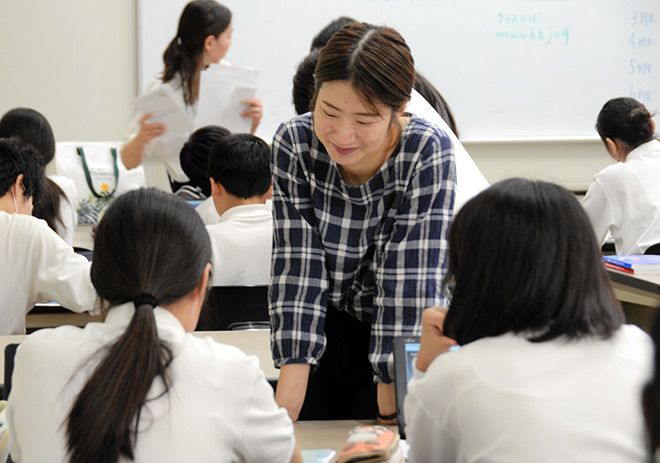Of Osaka’s 24 administrative wards, Ikuno is a lively district long known for its deep multicultural roots—a trait that has grown even more prominent in recent years thanks to an influx of students from diverse backgrounds.
The ward is now home to residents from roughly 80 countries, offering a vivid snapshot of Japan’s accelerating multicultural transformation with the rapid expansion of Japanese-language schools as the key driving force behind it.
A recent survey put the total number of schools in the ward at eight with two more just across the border in neighboring Tennoji Ward. Notably, six have either opened or relocated there since 2019.
Under Japanese law, language schools are, in principle, required to own their land and buildings. Compared with Osaka’s city center, real estate in Ikuno remains relatively affordable, making it an attractive option for new schools seeking space to grow.
The buildings themselves embody the spirit of renewal. Former company dormitories, wooden houses, showrooms, traditional restaurants and even religious facilities have been reborn as classrooms.
One school moved into a building once owned by a footwear wholesaler that had gone bankrupt; when staff first moved in, one of the floors was still stacked with boxes of unsold shoes.
DEMOGRAPHICS SHIFT
As of the end of March, some 3,600 international students were living in Ikuno Ward—roughly double the number recorded three years earlier. Vietnamese students made up the largest demographic before the COVID-19 pandemic, but the balance has since shifted.
Today, growing numbers of students are arriving from Nepal, Myanmar, Bangladesh and Sri Lanka. Some now say that as the student population swells, finding part-time work has become increasingly difficult.
Japanese-language schools have been making consistent efforts to maintain good relations with local residents. Staff teach students how to sort garbage correctly in dormitories, remind them to observe bicycle traffic rules and discourage large gatherings outside convenience stores and neighborhood shops.
One such institution, Well Japanese Language School, first opened in Osaka’s Taisho Ward in 2017 before moving to a larger building in Ikuno in 2019. Today, it boasts around 150 students—many of them from Myanmar.
The school’s administrative director, Masateru Sugioka, 61, a former engineer at a home appliance maker, regularly attends community meetings to share updates and accepts invitations for students to participate in local festivals and volunteer events.
“It’s rewarding to interact with them,” he said. “I want local residents to experience that same joy and see the vitality these students bring to our community.”
ACTIVE IN LOCAL COMMUNITY
In mid-October, 21 international students from Howdy Japanese Language School visited a community center in the southern part of Ikuno Ward. Organized as part of the school’s curriculum, the visit served as a cultural exchange with 17 senior locals who welcomed the young guests with warmth and curiosity.
After dividing into three smaller groups for introductions, students from Nepal and Bangladesh began sharing stories about their home countries spanning culture, customs and cuisine.
The elderly participants, amused and eager to learn, peppered them with questions: “Why do so many of you have beards?” “You eat meals with your hands? Doesn’t it get hot?” “What are your hobbies? Cricket? What’s that?”
Nineteen-year-old Thapa Hira from Nepal smiled when an elderly woman beside him asked gently, “You came to Japan all by yourself? You must feel lonely.”
“I’m fine,” he replied with a grin. For the next hour, the hall buzzed with laughter as the students talked about their part-time jobs like cleaning hotel rooms and sang folk songs from their respective countries.
After returning to school, the students wrote thank-you letters in Japanese.
“Kyo wa zuibun tanoshikatta desu” (Today was super fun), Thapa wrote. His teacher gently noted that “totemo” (very) would sound more natural in this context than “zuibun.”
Takami Kamei, 82, praised the exchange.
“Even though we live nearby, we rarely get the chance to talk. This was wonderful,” said Kamei who heads a local neighborhood association. “Some tourists staying in private lodgings behave poorly, and that sometimes gives foreigners a bad name. But these Japanese-language students are polite and take part in community events—everyone appreciates that.”
Howdy Japanese Language School was founded in 2019 by a social welfare corporation based in Wakayama that operates child care and disability support services. About 200 students, mainly from Nepal, are currently enrolled.
A new second campus is being built nearby this year that is expected to increase the student body by another 100.
Beyond the senior exchange, students have taken an active role in building ties with the local community, joining summer festivals in borrowed yukata and selling homemade desserts from their home countries at food stalls.
MODEL FOR THE FUTURE
At nearby public elementary and junior high schools, the Japanese-language school has held teacher-training sessions on using “easy Japanese” and expanded support for pupils with foreign roots since last year.
At Higashi-Ikuno Junior High School, Japanese-language teachers and international staff take part in extracurricular activities once a month after classes.
Together with about 30 students from China, the Philippines and other countries, they are engaged in reading with learning materials developed by a Japanese-language school and creating multilingual picture books.
“We still lack expertise in teaching Japanese as a second language, so their support is invaluable,” said Vice Principal Toshimitsu Meguro.
Last summer, Ikuno Ward signed a formal partnership agreement with Howdy Japanese Language School.
Principal Tatsuya Kozaiwa, 61, expressed a goal that extends beyond the school grounds: “Precisely because Ikuno is home to so many foreign residents, we want to build a new model of cooperation between Japanese-language schools and the local community—one that begins right here.”


AloJapan.com